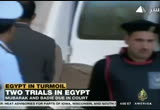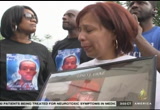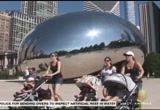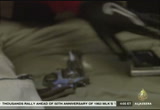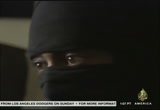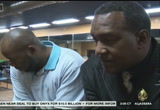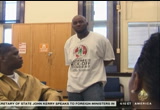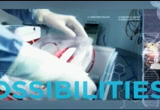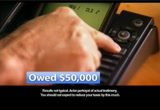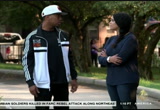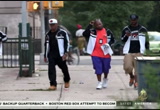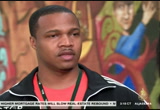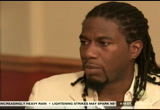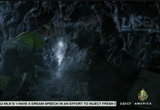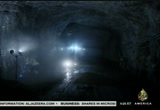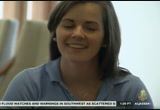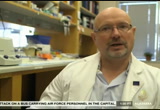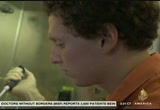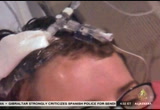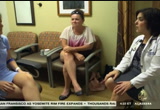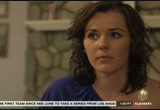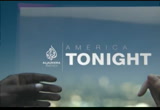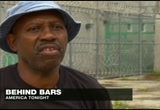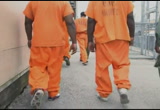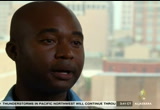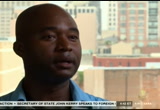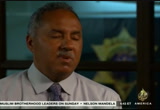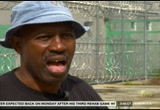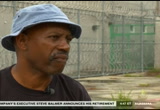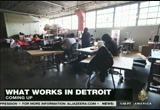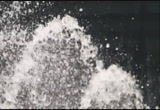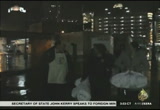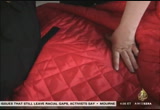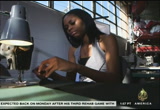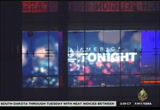tv America Tonight Al Jazeera August 25, 2013 4:00am-5:01am EDT
4:00 am
♪ welcome to al jazeera. this is your news on the hour. a pom blast in the capital of yemen has left one dead dozens wounded. witnesses say that the bomb planted aboard a bus carried officers from the yemen air force. the six killed were riding to an air force base. the yemen security forces call the bombing a terrorist attack. former president of egypt hosni mubarak and muslim brotherhood leaders are making court appearances today, facing charges over the death of
4:01 am
protesters. in syria, doctors without borders say that their medics have treated thousands of patients for neuro toxic symptoms. the california rim wildfire moves now into yosemite national park after destroying 200 square miles. those flames are posing a threat to the kansas city power and water systems, prompting the governor to declare a state of emergency. that is a check of your headlines. complete news coverage for you at 7:00 eastern analogon to al jazeera.com for more.
4:13 am
[[voiceover]] no doubt about it, innovation changes our lives. opening doors ... opening possibilities. taking the impossible from lab ... to life. on techknow, our scientists bring you a sneak-peak of the future, and take you behind the scenes at our evolving world. techknow - ideas, invention, life.
4:14 am
4:15 am
there's more to financial news than the ups and downs of the dow. for instance, can fracking change what you pay for water each month? have you thought about how climate change can affect your grocery bill? can rare minerals in china affect your cell phone bill? or how a hospital in texas could drive up your healthcare premium? i'll make the connections from the news to your money real. content while setting new standards in journalism. >> a new voice of journalism in the u.s., al jazeera america. america. >> we tell the human store ri from around the block, across the country. >> if joe can't find work, his family will go from living in a hotel to living in their car. >> connected, inspired, bold.
4:16 am
>> welcome back. we're keeping an eye on the gang violence that has taken over some chicago neighborhoods in our special series. but chicago is by no means the only city that faces those kinds of pressures. in brooklyn, community leaders have found a surprising group of allies in their fight against crime. we get that story tonight from sarah hoy. >> every time a victim is hit... >> before walker was speaking out against gun violence, he was wreaking havoc in the streets. >> i was out there every day, drugs, gang banger, i say that, i was out here jumping people, fighting people, you know, whatever we had to do. we were involved with a lot of violence on the streets.
4:17 am
>> how you doing, man? all right, all right. >> today the non-violence advocate is on a mission to save young lives. it's a summer evening and walker is making his way through brooklyn. after learning that two people were shot in separate incidents early in the week. they have gone almost 50 days without a shooting. he sees patrolling the streets as saving our streets. it's a community based effort dedicated to reducing gun violence. each of the men with the same mission and each can with their own past. most of them have a criminal record. instead of running from their past, they embrace it, and now they're fighting a different battle with different weapons. >> i got caught up with the street life, wanting to be somebody, and wanting to be involved with certain groups.
4:18 am
and consequently, i took a young man's life and went to prison. i wanted to be part of the change because i saw too many mothers, too many fathers and too many relatives grieving when their loved one was shot, their loved one was killed. and after serving so much crime and actually committing the crime i committed, i didn't want that to be done to another young man or woman, or have somebody else's family go through what my victim's family went through. >> >> reporter: and what do you want to say to those who might say, you have a criminal past, what good could you be doing here? >> i want them to know that everybody has the opportunity to change for the better. who you once was doesn't mean that's who you always have to be. if you believe in the power of change, why not give everyone that chance? >> >> reporter: the murder rate in new york city is at its lowest in 50 years.
4:19 am
there's no one single cause, but a study shows that when compared to similar neighbors, crown heights had less gun violence because of sos. groups like sos are forming across the city with groups trying to take back their streets. >> when i say stop shooting... >> he represents the nearby flat section of brooklyn, and he says that the sos call to non-violence is being heard. >> without the community stepping up and saying, we're going to do our part, everything else is going to be futile. it may work for a bit, but we haven't gotten to the cure of the problem. the core of the problem. we haven't gotten to what is actually causing the issues and dealing with those people specifically, it's not going to work, so we need the community to start saying, this is the problem, and they have.
4:20 am
>> >> reporter: back in crown heights, walker said violence just a police problem, but it's a public health problem. >> hi, s.o.s., stop violence, you heard of us before? >> yeah. >> that's the key, you need to talk to the individuals, and if you get them the treatment that they need, it's most likely that that individual won't spread the disease to somebody else. you got a lot of peer pressure, and a lot of people seeing what their friends are doing, and you havyouever the follow the crowde people that the to follow what everybody else is doing, and it's hard to get out of it. you don't want to look like a punk, you don't want to look like the person doing something different. >> so who here at the table has been affected by gun violence? >> doing something different is exactly what this group of teens wanted to do when they joined the new s.o.s. youth group.
4:21 am
>> it's sad knowing that we can't walk around in our own community. and this shouldn't be normal. this shouldn't be something that we have to experience every day. >> >> reporter: why is it important to be part of this? >> . >> i think if part of this, you'll just be again a part of the group, and not standing up. so i think for us to be doing this, hopefully, we can start a chain reaction, and maybe everybody can be part of it someday. >> i live every day with the fact that i took a life, and seeing that lives are still being taken every day, it's my way of trying to find forgiveness. i met with the family of the victim, and they have forgiven me, but it's hard for me to forgive myself, knowing that i did exactly what people today are actually doing out here continuously.
4:22 am
so for me, it is redemption. >> >> reporter: for members of s.o.s., hitting the streets is more than just give the kids a chance. it's about giving them a chance too for a second act. >> and that report from our sarah hoy. looking every day across the world, large amounts of high level radioactive waste created by nuclear power plants are placed in temporary storage. in finland, the first permanent repository is being made out of solid rock, and it has to last 100,000 years, because has long the waste remains hazardous, and we go inside. >> he recognized that this could happen, that you might find an open place.
4:23 am
you refer to that as human intrusion. we don't want this to happen because you make it heard, but most of all, we're afraid of human intrusion because it's open, the waste will no longer be isolated from all living organisms, and we will have failed. in fact, we consider you the main threat to the safety.
4:24 am
>> if someone in the future is able to dig down to the repository, it will probably be a civilization of the same kind as we have presently, and as such a case, they would also be knowledgeable. to know that this is a radioactive material. >> yeah, i think that's the most probable scenario, but i'm not so sure. it could be another situation. i think if somebody found a facility like that, in the future, they might interpret it as something religious.
4:25 am
a burial ground, or a treasure. >> if we look at the pyramids, we can't really say that we understand everything about the significance of their erection. but we can assume that this could be the same for our repository. it will be interpreted in the same way as we interpret the pyramid. there's no clear understanding that we won't be understood by the future, .
4:26 am
>> on sunday night, eastern, 6:00 pacific. >> when doctors fight one disease, and another. every sunday night al jazeera america presents gripping films from the world's top documentary directors. >> this is just the beginning of something much bigger. >> thank god i didn't have to suffer what he had to go through. >> this sunday, the premiere of "into eternity". >> i am now in this place where you should never come. >> how do you contain 100,000 years of nuclear danger? >> it is an invisible danger. >> al jazeera america presents "into eternity". premieres sunday night 9 eastern.
4:29 am
>> more than one in three americans will be diagnosed with cancer at some pine if their lives, and when that diagnoses is a malignant brain tumor, it's often a death sentence b. not always. a young woman with a revolutionary therapy, a killer force for good. meet stephanie. the pain in stephanie's head began in the spring of 2011. >> i just started noticing the back of my eyes would hurt bad, and then the migraines started. i couldn't bathe myself, dress myself. all i could do was lie there in pain. >> >> reporter: the headaches became so bad that stephanie checked into the local er. >> they found something, and took her to greenville. and i hit my knees. >> >> reporter: doctors found
4:30 am
the tumor in june and operated almost immediately. fears. >> any time anybody says the cancer word, you automatically think the worst. >> >> reporter: it was a very aggressive, pediatric brain tumor. >> >> reporter: for nearly a year, they battled it with therapies, conventional therapies that 95% of the time only delay the inevitable. >> in april of 2012, i was given the news that my cancer had come back. >> this disease, especially when it runners after surgery, radiation therapy. >> but a revolutionary new therapy by cancer specialists at
4:31 am
duke university gave her one last hope. er in dr. mathias, a you'reeologist a ur onologistwho is trying to h another disease. tumors. >> his therapy involved using a weakened polio virus, with receptors that exist naturally on many cancers. >> the polio virus likes to infect cancer cells, and when that happens, it kills them. >> >> reporter: but more importantly, it triggers the patient's own immune system. >> you might say that the virus is the spark that makes it recognizable to the immune system. it involves putting a catheter into the brain, and the virus is
4:32 am
put into the catheter. >> polio kills, you know? i didn't think that that was a good idea. >> she's like what? you're putting polio in my daughter's brain? are you serious? >> it took me a little bit to get used to the idea. but it was stephanie's decision. >> the doctor actually came in and explained it to me, and i was just amazed. and i was like why not try it. it had not been used on a human yet. it had only been done on monkeys and that's how they explained it to us. >> >> reporter: over a six hour period, a surgeon infunnel cloud 1 million virus particles into stephanie's brain. >> i was the one who started the fusion pump to deliver the virus, and it gave me a great level of confidence that we were doing the right thing. we had studied this so thoroughly.
4:33 am
>> >> reporter: yet in the months after the infusion, the tumor, disturbingly, appeared to be growing. >> it's something that nobody wants to see, and i have to be honest that it's not something that we were happy about of it. >> how are you doing? >> as a neuroncologist deals with this cancer, when i saw the tumor growing, it was scary for me to sit back and have faith that the polio virus will be work. >> >> reporter: wha >> what was actually happening in her brain was an inflammatory response, rather than the tumor growing. >> >> reporter: in fact, it was as predicted, attacking the tumor with the polio virus. >> this is a diabolical disease, but the fact that she responded
4:34 am
the way she did to the virus is remarkable. because this is not something that was achievable with any type of treatment that's conditions. >> and this whole area here was the tumor that we treated, and how it's gone, see that whole area? >> i'm really pleased. >> you're happy too? >> congratulations. >> by december, seven months after treatment, there were signs that the tumor started to respond, and in february, nine months after treatment, we knew that her tumor was responding. >> >> reporter: studies suggest that once the body recognizes and destroys the tumor, it won't return. >> producing a lasting response against the tumor is the holy grail in cancer therapy. we don't stop at brain tumors, we want to investigate a
4:35 am
use of the techniques that we're currently testing in order to make a department against currently incurable cancer. >> >> reporter: if stephanie and the other remain tumor free, his technique could be used to fight a range ofern cas, including minute ago that melanoma and others. stephanie has now survived a year and a half, four times longer than most people with her disease. and she's in perfect health. >> i've still got cancer, and i'm a cancer surviver. not only cancer, but brain cancer, and people look up to me, and i've grown so much. not only have i matured more, but i found out who my friends were, and realize i can go through anything if i can beat cancer.
4:36 am
>> other patients are being evaluated to participate in the trial. so far eight patients have been treated and responded like the others. but it didn't help two others who had significantly damaged immune systems. and we're waiting on the other four. but once the body recognizes a tumor, it won't come back. next up, one of the most out of control jails in america. >> this is a public safety problem. when people come out of jail who have been misused and abused, that person is in a bad place. >> we examine this broken system and what it's doing to the city of new orleans. on techknow, our scientists bring you a sneak-peak of the future, and take you behind the scenes at our evolving world. techknow - ideas, invention, life.
4:37 am
4:38 am
my name is ranjani chakraborty, i'm from houston, texas, and i'm an associate producer for america tonight. i grew up in a very large, loud indian family. they very much taught me how to have a voice, and from a very young age i loved writing, and i love being able to tell other people stories. the way to do good journalism is to really do your research, to know your story, to get the facts right, and to get to know the people involved in your story. america tonight and al jazeera america, it's a perfect place
4:39 am
for that to happen. >> welcome back, louisiana has the highest incarceration in the world because of new orleans, the justice department and the sheriff are all battling over jail reforms. it is graphic and may be disturbing. >> in the shadow of downtown new orleans. >> the wall and the fence is not to keep people in, but to keep people like y'all out. >> it's called opp by the locals. >> why do they want to keep us out? >> because nobody wants to know what's going on inside of the prisons. >> it's called the most dangerous jail in america. >> thanks for having us. let's head on in. >> america tonight takes a rare
4:40 am
look inside. until now, few cameras have been allowed behind these barbed wire fences. >> violence here, an everyday event. so these were built after katrina? and how many of them are there? >> 88. how many inmates per these? 88. >> you got a lot of guys in these. >> the state of louisiana has the highest incarceration rate in the entire country. twice the u.s. average. 38,000 people come through o.p.p. every year. some do not survive. according to federal investigators, 40 inmates have died here since 2006. 25 prisoners hospitalized every month.
4:41 am
the jail had 698 prisoner assaults last year, including 32 stabbings. this photo shows the aftermath of a recent stabbing in the jail. the sheriffs' office issued a statement that a prisoner received "superficial cuts." in this bunk, two guards are on duty. >> who it is watching the inmates while you're in there? from up there. >> horror stories are abundant, documented in federal lawsuits. durrell rashard, who was just released, was sexually assaulted in o. p.p.. >> this is like another inmate? >> yes. he woke me up early in the morning and told me to get in the shower, and by him saying that, pretty much, you have to do what he says, and i was forced to get in the shower. and after i get in the shower, i notice that he has a shank, and
4:42 am
he places it by the entrance of the shower i guess as a warning to me, that if i didn't comply, i would be stabbed. >> >> reporter: rashard is one of 400 prisoners who testified in what was a class action lawsuit on behalf of all prisoners at o.p.p. the u.s. justice department joined the lawsuit, charging violent, inhumane prison conditions, excessive force, and deprivation of healthcare, and suicidal policies. >> i witnessed inmates performing oral sex on a lot of the guys on their tier, and another inmate, who was definitely schizophrenic getting drugged on the tier and having a broomstick shoved up his rectum. >> they can spin some great stories. we investigate
4:43 am
every single allegation. >> the church runs it. dubbed as a reformer and first black sheriff, some say that he's part of the problem. he says that the allegations of danger and neglect are overstated. >> 60 deaths since 2006? >> yes and no. they would have you think that all of these are related to some sort of violence. and there has only been death to violence since i've been sheriff. you have groups that twist the truth for their own purposes to make people like you and your audience think that, when they look at a number like that, that that's somehow wrong. >> but u.s. justice department statistics show the mortality rate for prisoners here in o.p.p. among the highest in the u.s. >> you're investigating, this is closed down [ inaudible ]
4:44 am
>> >> reporter: earlier this year, public outrage grew, when this video, filmed by a prisoner, was released to the media. one prisoner is filmed coming and going at will. behind bars, inmates not only showed off drugs they had in their prison cell, but somehow they obtained a handgun, defiantly waving it around to the camera. the laundry lists has led to a number of protests. >> it continues to be -- >> the caretaker salaries that we're paying to jail people we could be paying in their communities, that would be useful. >> new orleans mayor, rich landreau, wants sheriff gusman out. >> some of the officials in the town have been highly critical of you. how do you handle it? you want me to name some names?
4:45 am
the mayor? >> the mayor has his own agenda, and i'm not going to get into what his agenda is, but i have a record of public service in this community. >> has the jail been politicized? why are you being criticized? >> i think this is a tough job, and i think when someone stumbles, it's usually some people's opportunity to take a hit at them. and we have had some stumbles,s this no doubt about t >> >> reporter: earlier this year, sheriff gusman and federal officials reach add sweeping agreement for staff for prisoners, mental health reforms, improvements to healthcare and more. the federal government is also pumping $145 million into the
4:46 am
jail by paying for the state-of-the-art building. sheriff gusman says the new facility will fix many of the problems. but reformers say the jail still won't have proper medical and mental health facilities. they also take issue with the size of o.p.p. it will still how's more than three times the prisoners per capita than the u.s. average. >> this is where the prisoners will be. >> this is where they will be, and then there will be additional security behind here. >> he's sceptical. he spent 27 years behind bars. since his release, he has been a reform. >> the prison conditions have been like this for i would venture to say the last 35 years. the minute people stop being prosecuted, being sued and litigated against because of the conditions in jail, that's when all of the attention comes. >> who do you blame for all of this?
4:47 am
>> i blame this administration, the sheriff, i blame this mayor, i blame the previous sheriff and the city council because everybody has turned a deaf ear ear to and the sheriff inherited a bad situation, and he hasn't made it any better either. >> >> reporter: new orleans has the third highest murder rate in the u.s. in some neighborhoods, violent crime is part of everyday life. >> this is a public safety problem. because when people come out of jail who have been misused and abused, you know, that person is in a bad place. >> if they really make a genuine effort and they fix this jail, how well that fix the overall city of new orleans? completely. a lot of the problems we're having in the city stems from the jail and visa versa. >>
4:48 am
it disproportionately affected african-americans. one out of seven males are locked up or on parole. >> we're starting to have a conversation in the city will incarceration. it was the panacea for everything that went wrong, just lock them up. >> >> reporter: sheriff gusman still says that he's a reformer, everything that is wrong with new orleans. >> it is in some respects a contradiction in terms of someone who is a champion of individual rights and freedoms is also responsible for the incarceration, but that's part of what we have to do. >> >> reporter: are you hopeful for the day that this facility is too big? >> i'm hopeful for the day when we have very few people in here, and the smaller the facility, the better we're going to be as people. >> we have to take a real hard
4:49 am
look at when we have this crime for law and order, what that looks like, and what is the collateral damage that it does for the overall community. and standing over there on the front of the stairs by the courthouse, still ahead here, how one woman fashions an informant plan for the homeless in detroit. >> because we don't need coats, we need jobs. she was angry about it. i'm not going to let you get off the hook with creating a bandaid. >> far more than a bandaid, it's what works. it's getting single moms out of shelters and into homes of their
4:52 am
>> finally on america tonight, we introduce our series, what works. we visit a pocket of a bankrupt city where the idea of unemployment has been scrapped and one woman is helping others stitch together a better future. >> >> reporter: downtown detroit on a warm and beautiful summer day. for the sun seekers here, the biting chill of a michigan winter seems very far away. but in a warehouse, two miles from the city center, that's
4:53 am
exactly what they're focused on. nine seamstresses working nine hours a day to turn out winter coats for the most vulnerable population, the homeless. it's a non-profit that employees women who have been homeless or living in shelters. their job is to sew winter coats to the destitute. it's founder is veronica scott, a graduate of college for creative studies. the idea grew out of a design class project. >> we were given an assignment to fill actual needs or for a trend or planned obsolescence. and this coat came out of that class project. >> her research took her to the city's homeless shelters. she tried to figure out what people who live on the street really need to survive. veronica found that a
4:54 am
heavy-duty garment would protect them from the elements. and she came up with a hand sewn prototype. which she proudly displayedful. >> they all tried it on, and it was their first prototype. not just mine. the idea was, it's a great idea, but it looks like a body bag. >> so veronica took that initial idea and kept improving it, working on the coat and returning to the shelter for feedback. >> i think the fact that i did the research with the people i was trying to reach out and at the end of the five months, i was known as the crazy coat girl, or the white coat girl, any mixture of those words, that was my street name. >> >> reporter: but one night, veronica got into an angry confrontation with a woman at the homeless shelter. >> she said we don't need coats,
4:55 am
we need jobs. i'm not going to let you get off the hook with creating a bandaid. >> veronica was forced to think about not just giving it to people. >> a coat on its own is not going to change anything. but if i go in and hire the people living in the shelters who would be on the receiving end, rather than just giving it to them. >> it was born. after making a rough business plan, she was introduced to carhart. and that went remarkably well for a 21-year-old who lived in her parent's basement. >> the next day i get calls from tennessee and new mexico and they said, we have 24th tons of equipment and hundreds of yards of fabric and needles and buckles and everything being shipped and we have them for this home address. is that okay?
4:56 am
they were all being shipped to my grandparent's house on two freight trucks. >> after that initial treasure trove from carhart, these water resistent shells and plenty of good advice, veronica got a surprise call from general motors. and the automaker offered her another key ingredient for her design. >> between the red and the black is this insulation. it's from gm, from their scrap, and it's put inside of the gm door panels to insulate and sound deaden the whole car. >> and this is the result, a transportable, water resistent heavy-duty winter coat. it closes with velcro, and it has a sleeping bag built in, that can be entered without taking the coat off. and it's big for possessions in fact. and to sew it all together, that's where the ladies, as
4:57 am
veronica calls them, enter the picture. all single moms, formally in shelters, all desperate to work. none with no seamstress experience. >> we bring them in. and we do a month, you're sitting in front of a machine that's basically a car motor attached to a needle. it's intimidating and let's get you comfortable with t. >> the women earn 8-$12 an hour, based on their experience. many are able to leave the street life and afford places of their own. already 15 have worked in the program. >> they transition from being homeless to being in a shelter to their home for the first time in a long time. a stable home this they know they can pay for. >> >> reporter: one of the newest hires is tia sands. she has been there for four months. a mother of two, she was separated from her children and
4:58 am
desperate to reunite with them when a social worker mentioned the empowerment plan. >> i seen something different, okay, this may be a possible good job. so i filled out the application, and i told her, don't forget my face because you'll see me again. >> tia got the job. >> when i walked in here, all i thought about was my kids. if i have a job, i can get my kids back, and that got me excited. >> since starting with the empowerment plan, tia has moved out of the shelter and in to an apartment with her kids. >> my daughter tells me all the time, mommy, i'm proud of you. she told me on the 4th of july, it almost made me cry, i'm so proud of you, mommy, because you love us and you're always taking care of us. i said, how old are you? >> detroit may be bankrupt, but veronica scott is determined to
4:59 am
show it has a heart. knowing that those out on the street will struggle and suffer this winter, just like the last, so the ladies of the empowerment plan will cut, and back stitch and help every day and deliver 4,000 of these coats to the people who need them the most. it's their way of helping the homeless and helping themselves out of poverty long the way. >> ri a terrific report from chris burre. you can join the conversation on twitter with us or at our facebook page. have a great weekend.
5:00 am
>> back in court, the retrial begins for ousted egyptian president kno. >> hello, you're watching al jazeera. the u.s. reviews its military options in syria after a suspected chemical weapons attacks on civilians. uncertain return home, we follow the journey of an afghan refugee to a land none of his children have ever known. plus, zimbab wr. e hosts a tourism summit hoping to convince weary travelers to return.
65 Views
Uploaded by TV Archive on

 Live Music Archive
Live Music Archive Librivox Free Audio
Librivox Free Audio Metropolitan Museum
Metropolitan Museum Cleveland Museum of Art
Cleveland Museum of Art Internet Arcade
Internet Arcade Console Living Room
Console Living Room Books to Borrow
Books to Borrow Open Library
Open Library TV News
TV News Understanding 9/11
Understanding 9/11
